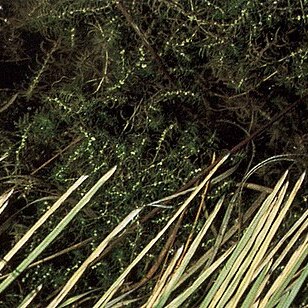Plants always submerged. Leaf blades all ± lingulate or tapering from base, 5.5-15.3 × 0.6-1.8(-2.2) mm, translucent, slightly to markedly narrower at apex than base, with a single vein. Flowers solitary, a staminate flower or carpellate flower in 1 or both of a pair of axils; bracts lacking; styles 0.6-2.4(-2.5) mm, initially erect, recurved and eventually appearing to emerge below apex of mature fruit; filaments 0.5-0.9 mm, erect, continuing to grow after dehiscence; anthers (0.1-)0.2-0.6 × 0.2-0.7 mm, reniform, translucent; pollen grains colorless, ± circular, 20-30 × 20-30 µm, smooth. Fruits dark brown when mature, 1.2-2.4 × 1.2-2.9(-3) mm, ± as wide as high; mericarps divergent, such that from above fruit appears crosslike; testa cells in rings; fibrils only in wing cells.


